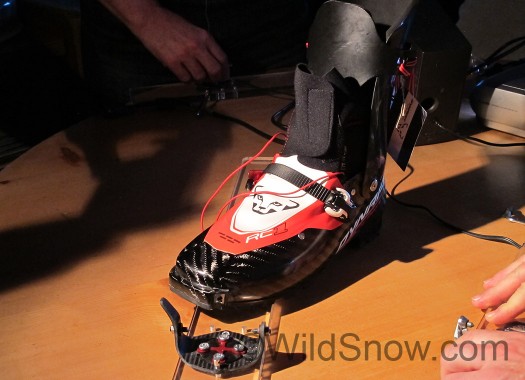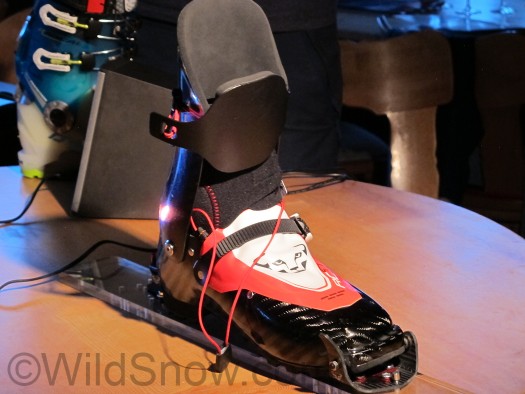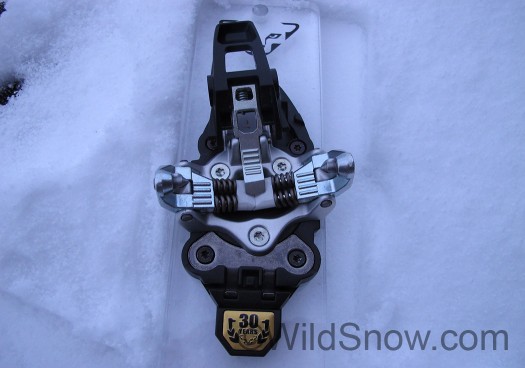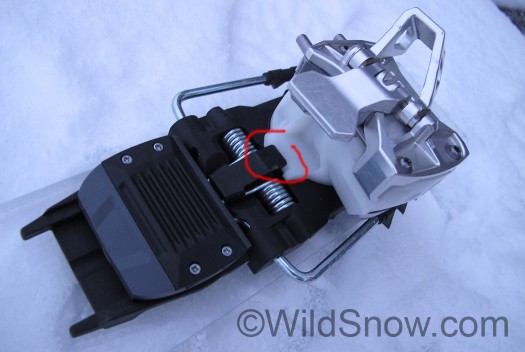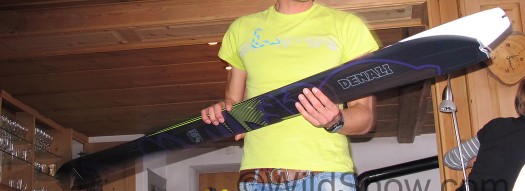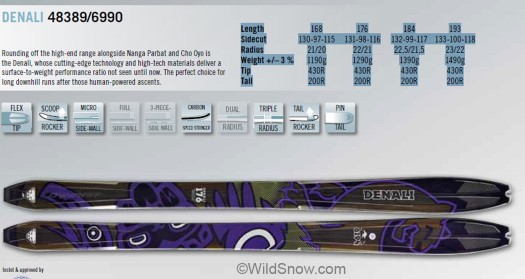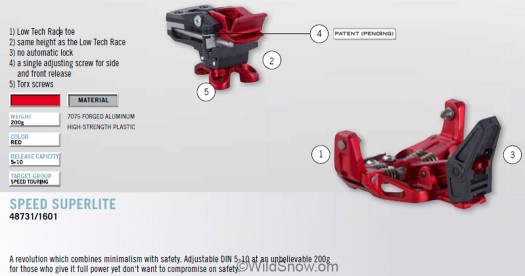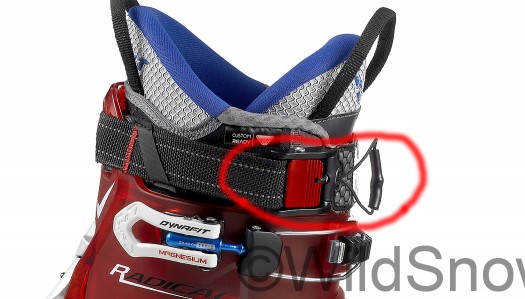Updated January 15 (Note: due to the strong readership we’ve been getting from Europe over the past few years, we’ve decided to cover larger and sometimes complete range of products when we write overviews about any given company. We will NOT be drawing a distinction between what is imported to which country and what is not. In other words, our coverage will be global and we’ll leave it up to importers, PR people and shoppers to figure out where to acquire products.
We’re here in Switzerland checking out Dynafit’s new products for next season. Overall the innovation in bindings and boots continues, trend being evolution of existing products.
Perhaps biggest news for those of us still focused on lightweight ski touring is that Dynafit has partnered with Pierre Gignoux, the famed French carbon fiber boot maker. Working with Gignoux, Dynafit will brand a 500 gram full carbon race boot as well as a 75 gram binding (both of which work only with each other). While this stuff is high priced and designed only for racing, it is exciting because things of this sort may trickle down to the ‘normal’ ski touring market. So look for your gear getting simpler and lighter — if you like it that way. Otherwise, the latest crop of full-feature tech bindings continue to gain weight and complexity — but in doing so may become safer and easier to use.
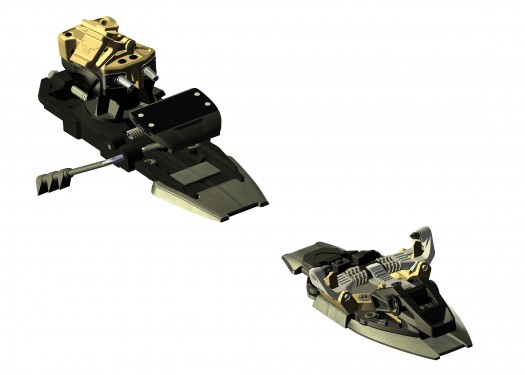
Check out the Radical ST 2.0, heel has 10 mm fore/aft travel via heel spring that's now included in all Radical bindings. Main improvement is a much more positive brake and anti-rotation lock, as well as the toe jaws being mounted on a rotating platform for possibly smoother and safer release similar to that of the Beast binding.
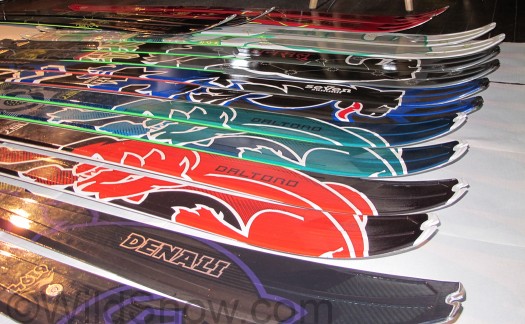
New ski lineup for 2014-15, some new models, some the same. Denali looks good and Manaslu will be available as well.
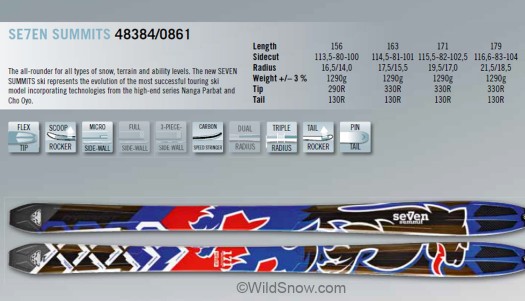
7-Summits used to be THE go-to touring ski. Will the new version deliver? Quite possibly. It's still an '80' waisted classic EU plank, but is fattened up to about 81 at the waist from the original 78, though maintaining essentially the same sidecut. Probably a bit lighter as well.
From what I saw, most significant changes in Dynafit products are in the bindings. Nearly all the binding get a facelift, heel ‘forward pressure’ springs, what appears to be stronger heel unit top plate, and a rotating toe unit that perhaps helps with safety and elasticity/retention but we suspect is more about chasing certifications that will facilitate retail sales. Thankfully, the Speed Radical model binding remains the same, and for anyone wanting the lightest and simplist Dynafit ‘pintech’ ski binding this will perhaps remain the sweet spot in the lineup.
Here is the binding lineup for 2014-2015
Here are the 2014/15 binding offerings, with notes. I’ll add to the blog post above.
Low Tech Race (Possibly limited life span, only recommended for racing.)
Expedition (Super light, no side release.)
Speed Superlight (Somewhat of a race binding, crosses over to touring, might actually be our favorite once we do more testing.)
Radical Speed (Our fave, same as 2013.)
Radical Speed Turn (The classic TLT with heel lift requiring spinning the heel unit.)
TLT Radical 2.0 ST Anniversary (Golden color plated.)
Radical 2.0 ST (New Radical with turntable toe).
Radical ST (Old style, continued from 2013.)
Radical 2.0 FT (New FT with turntable toe.)
Radical FT (2013 FT version of Radical)
Beast 14 (New version with simpler looking turntable toe, less weight, RV 14.)
Beast 16 (2013 Beast with a few changes, RV 16.)
Beast 16 (2013 version with large complex toe unit)
For you tech oriented folks, more about the rotating toe unit: it’s quite simple, ingenious. Just a recessed turntable affair that you’d hardly know is there. In function, as well as smoothing out release the rotating toe takes over the elasticity previously provided by the toe pins riding in and out of the boot toe sockets (though this probably still happens at some point in the boot movement process.) In an ideally configured pintech system, the boot toe sockets work amazingly well in allowing the binding pins to ride smoothly through their range of travel. In the real world, however, it’s proved to be difficult to consistently achieve this due to manufacturing variances, system wear and so forth. That said, hundreds of thousands of ski tourers have been perfectly happy with non-rotating tech binding toes — for nearly thirty years! Conservative point of view? Yes. Main thing, with any tech binding system do a thorough release check on the shop bench. Everything should work smoothly, with normal release values, smooth exit from the binding (not catching or sticking) and smooth return to center action.
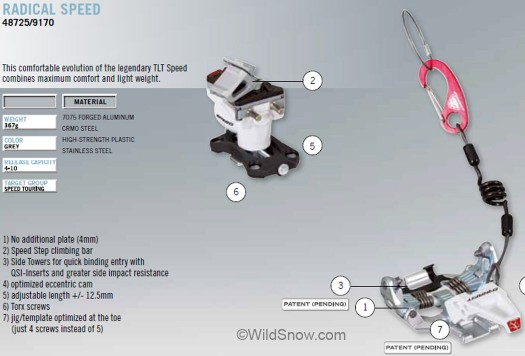
Speed Radical remains the same, and in our opinion is still the sweet spot in the lineup for any serious backcountry skier looking to save weight yet maintain full function. We recommend a 3mm plate (more or less) under the toe unit for less binding ramp-delta.
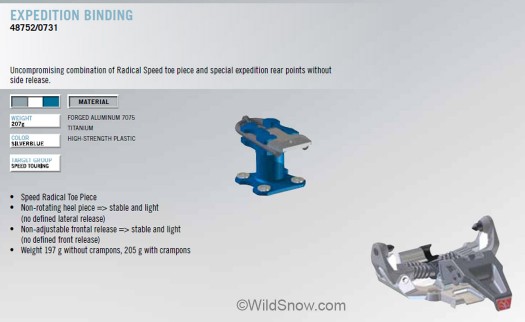
Expedition binding has no lateral release and what we suspect is probably an RV of around 9 for vertical release. We'll check on that. Idea here is minimal weight for folks such as low angle trekkers as well as extreme skiers.
Press Release Winter 2014-15
DYNAFIT CELEBRATES 30TH ANNIVERSARY, INTRODUCES RADICAL 2
30 YEARS LOW TECH
2014 is a year to celebrate: The Low Tech frameless binding system turns 30 years old. In addition to the outstanding success of the touring bindings, ski touring specialist DYNAFIT and binding inventor Fritz Barthel are also celebrating their longtime partnership. As part of the celebration and to underscore its expertise in the binding segment, DYNAFIT will introduce the new Radical 2 model three decades after the invention of the frameless system. With this new model, the development team has succeeded in taking a significant forward step in safety and comfort.
In 1984, Austrian Fritz Barthel had his patent approved for the system that years later became a groundbreaking
and globally recognized invention. Created in a basement workshop in Bad Häring, Tyrol, the Low Tech frameless
binding system rose to become a symbol of the athletic, alpine activity of ski touring. DYNAFIT has developed
and sold the system since 1989. Ever since then, the company has had a special partnership and friendship with
Barthel.After climbing Mont Blanc in the early ‘80s, the mechanical engineer decided his gear was too heavy. That’s when he started to ponder a totally new binding construction: “The heavy frame of the binding had to be replaced by the boot if you really wanted to save weight – weight that had to be carried along with every step.” Thirty years later, his first idea has established itself as the leading binding system in the sport of ski touring. Fritz Barthel looks back fondly on his early ingenuity: “Laziness is the mother of invention.” Today, the unique DYNAFIT boot-binding concept has become the foundation of every other similar product development.
At DYNAFIT headquarters in Aschheim near Munich, Germany, further developments use this foundation. After
the continuing evolution of the so-called TLT binding, the RADICAL 2 model will be launched for Winter 2014-15. The Radical 2 combines safety and comfort while weighing in at only 599 g / 1 lb 5 oz. The rotating toe piece is the biggest update. First, it functions as an additional release mechanism; secondly, it increases side impact resistance. With this new design, a precisely coordinated release mechanism of the toe piece and heel unit is guaranteed. The release can be easily set to a Release Value between 4 and 10. The Radical FT model, which is made for descent-oriented ski tourers, can be set up to an RV of 12.In addition, the stand height of the Radical 2 has been improved; a lower height ensures direct contact with the ski. In order to match the binding to increasingly wider skis, this binding also has an extra wide mount area.
Additional technical details:
– 10mm forward pressure for length adjustment when ski is flexed
– Available stopper widths 90 mm – 135 mmThere will be a 30thth anniversary limited edition run of 2,200 bindings with gold-plated components.
Press Release Winter 2014-15
THE BEAST CONTINUES…
DYNAFIT BUILDS ON THE BEAST BINDING CONCEPT:
AND NOW WE HAVE 14
After the successful introduction of the Beast binding, ski touring specialist DYNAFIT expands the collection in the category of Freeride Touring, introducing the Beast 14 for next winter. The Beast binding addresses athletic, passionate Freeriders who seek a binding for every discipline and every terrain. The frameless system will now be combined with more strength up to a Release Value of 14. The Beast concept enters the next phase: The stimulus for this development is an ever growing target group that demands a freeride binding that combines comfort on the climb and performance on the descent. Weighing in at 795 grams / 1 lb 12 oz, the Beast is closer to being a climbing binding, yet still offers all of the characteristics of a sturdy freeride binding. The frameless system is equipped with a rotating toe piece, which is constructed to ensure a constant release value and to resist early release from side impacts. The heel unit takes on the technology of the Beast 16 binding, which releases at both the toe piece and heel unit. When it comes to the ride, developers Frederik Andersson, who is a former professional freerider, and U.S. professional skier Eric ‘Hoji’ Hjorleifson have realized their ideas: low stand height with 16 mm in the front and 23 mm in the back, as well as a lean angle of 6 mm. A low lean angle improves neutral ski performance and makes skiing easier on difficult terrain. In addition, the two professional athletes see both a binding’s torsional stability and high energy absorption as key criteria of a freeride binding. Thus, they have incorporated these characteristics into the development of the Beast 14. ‘Limitless Skiing’ continues… Next winter will rock!

Hmmm, here is the item I'm most interested in. Carbon construction 131-98-116. Rocker tip and tail. The ultimate powder harvester?
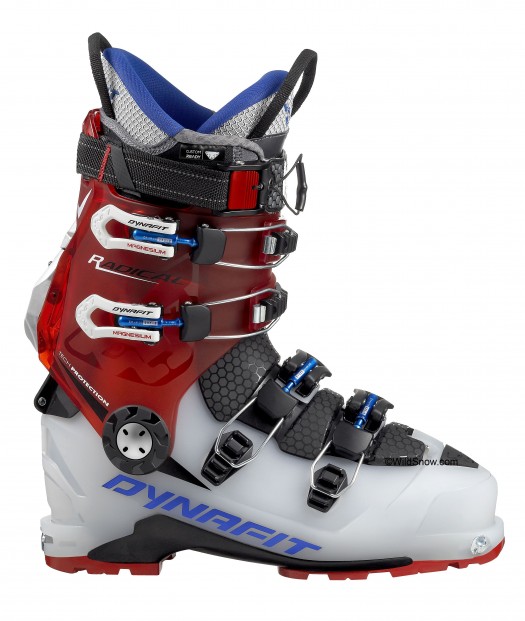
And check out the Radical boot. Probably more than I'll ever need, but how about you? What I like best about the boots is the power strap is now Dynafit's 'Motion Lock' system, consisting of buckle-strap instead of velcro, and with a small tab you pull on to quickly release for touring. This is a small improvement, but if you hate fooling with power straps it could be truly nice.
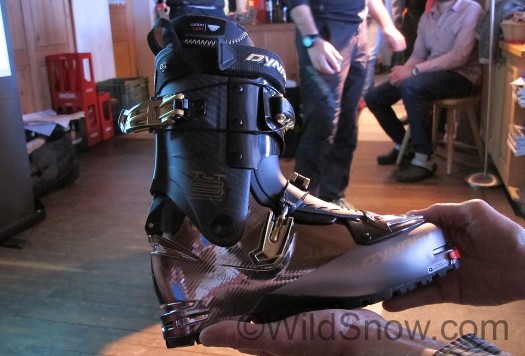
We like the look of this commemorative 30 years TLT6 boot, but the gold plated binding seemed over the top (is it really gold?)
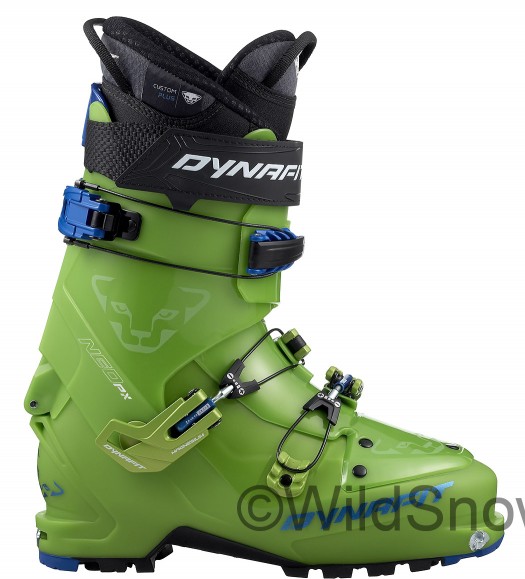
NEO boot takes the place of ONE. The buckle wrapping over instep is a key feature we'd like to see in all ski touring boots. This is a full Pebax boot, presumably for a broader market due to standard DIN sole configuration that works with any of the frame type touring binding models on the market. Frankly, our question with this boot is 'why?' considering what is happening with the pintech binding system (essentially, it's going huge).
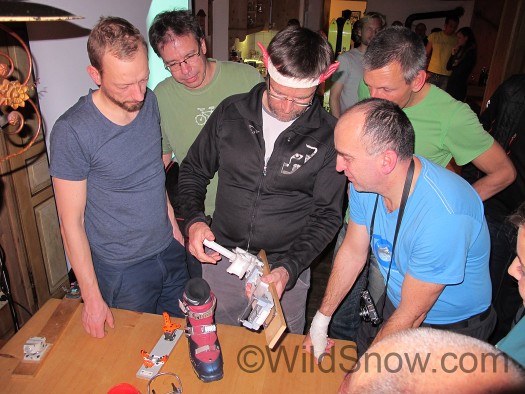
Tech binding system inventor Fritz Barthel gave a humorous presentation on the history of the tech binding, including sharing strange mechanical prototypes while wearing his special creative thinking headband. We were indeed celebrating the 30 year anniversary of the tech concept Fritz and his father Manfred started here in Bad Haering, Austria three decades ago. We'll cover this more in subsequent blog posts, but if you're interested in history remember to check out our binding museum using navigation menu above.
Other points I gathered:
-Dynafit is now making all their own boot liners (instead of sourcing from Palu) and all are thermo-moldable.
-The ski touring (not sidecountry or freeride) market is about one million people worldwide, with sales being a part of that.
– Beast 14 binding will come in at 1,600 grams, looks cleaner but still has heel with added vertical elasticity. Could be quite nice for the aggressive skier.
WildSnow.com publisher emeritus and founder Lou (Louis Dawson) has a 50+ years career in climbing, backcountry skiing and ski mountaineering. He was the first person in history to ski down all 54 Colorado 14,000-foot peaks, has authored numerous books about about backcountry skiing, and has skied from the summit of Denali in Alaska, North America’s highest mountain.

